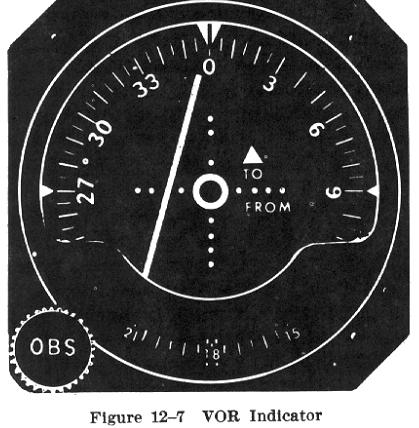
Because VOR receivers are manufactured with varying degrees of complexity, pilots should familiarize themselves with the receivers installed in the airplanes being used to understand the use and limitations of the equipment.
In addition to the navigation methods discussed in the preceding sections, the FAA provides several types of radio aids to air navigation. For example, the Very High Frequency omnirange (VOR) and the Low Frequency nondirectional radiobeacon (NDB) are particularly useful to VFR pilots for navigation guidance.
For many years, the VOR has been the basic radio aid to navigation. Transmitting frequencies of omnirange stations are in the VHF (very high frequency) band between 108 and 118 MHz. The word "omni" means all, and an omnirange is a VHF radio station that projects radials in all directions (360 degrees) from the station, like spokes from the hub of a wheel. Each of these "spokes," or radials, is denoted by the outbound magnetic direction of the "spoke". A radial is defined as "a line of magnetic bearing extending from an omnidirectional range (VOR)." However, due to the features of VOR receivers, it is possible to fly either to or from omniranges in any direction.
A few of the advantages of using omniranges are:
1. A flight may be made to a VOR from any direction by flying inbound on the selected radial.
2. A flight may be made from the VOR to any destination by flying outbound on the selected radial.
3. When within receiving range of two or more VORs, a fix or lines of position may be determined quickly and easily by taking bearings on the stations.
4. Static-free reception, and the elimination of complex orientation procedures, provide easy identification and utilization of the VOR facility.
An important fact is that VOR signals, like other VHF transmissions, follow an approximate line of sight course. Therefore, reception distance increases with an increase in the airplane's altitude. Conversely, flight at low altitude decreases the reception distance. A means is usually provided on omnireceivers to warn the pilot when the signal is too weak for satisfactory reception.
Though new and improved types of electronic equipment are constantly being developed to make flying safer and easier, VOR and VORTAC (VOR tactical Air Navigation) are the basic VHF systems currently in use for radio navigation. In addition to the bearing information obtained from the omnirange, VORTACs supply pilots of airplanes which have distance measuring equipment (DME) with the distance of the airplane from the station. In providing the bearing and distance, the pilots can determine the airplane's exact location, eliminating the need for taking cross bearings on two or more stations. However, pilots of airplanes equipped with only a VOR receiver can still use a VORTAC station for bearing information just as they use a normal VOR station. (Note: For simplicity, the term VOR will be used in this handbook to include both VOR and VORTAC stations.)
VOR stations are assigned three letter identifications.
At most stations these identification letters are broadcast continuously
in Morse code. Some stations are also identified by a voice recording (Example:
The spoken words, "Kingfisher V-O-R").
 |
VOR receivers are very simple to operate and consist of three basic
components used by the pilot. One component is the omnibearing or course
selector (OBS), which enables the pilot to select the course or radial
desired. A second component is the TO/FROM indicator, which shows the pilot
whether the selected course would take the airplane TO or FROM the station.
The third is a course deviation indicator (CDI - often called the"LEFT/RIGHT"
indicator), which by means of a vertical needle tells the pilot when the
airplane is on the selected course, or left, or right of course. Using
these three components, the pilot obtains visual indications which give
a variety of information and guidance. The "TO/FROM" indicator, omnibearing
or course indicator, and course deviation indicator are usually combined
into a single display on the instrument panel (Fig. 12-7).
Because VOR receivers are manufactured with varying degrees of complexity, pilots should familiarize themselves with the receivers installed in the airplanes being used to understand the use and limitations of the equipment. |
Since accuracy is an important factor in any navigation equipment, pilots should check their VOR receivers periodically to be sure they are functioning properly. Procedures for checking VOR receivers are published by FAA in the Airman's Information Manual.